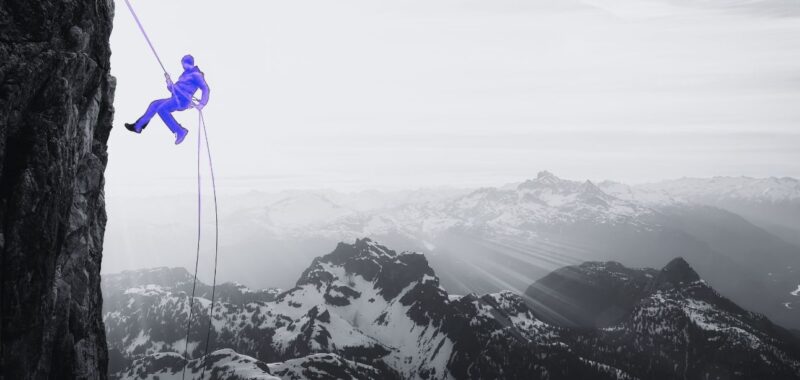M. John Harrison’s fiction is populated by characters in extraordinary circumstances, from a secret agent on a mission involving the very nature of God to a reclusive man who discovers evidence of a conspiracy inspired by aquatic species of humans. And then there’s his 1989 novel Climbers, which is about—as the title might suggest—a group of rock-climbing enthusiasts living and working in Yorkshire. No strange deities, no conspiracies, no otherworldly beings—just men, rocks, and trauma.
Article continues after advertisement
 It feels like an outlier in his bibliography, and in many ways it is. Even so, this dispatch from more than 30 years ago feels eerily prescient in its depiction of men seeking connection in a highly impractical and often life-threatening way. Or, to put it another way, M. John Harrison might well have written the great novel of 21st-century male loneliness—he just did so in the waning years of the 20th.
It feels like an outlier in his bibliography, and in many ways it is. Even so, this dispatch from more than 30 years ago feels eerily prescient in its depiction of men seeking connection in a highly impractical and often life-threatening way. Or, to put it another way, M. John Harrison might well have written the great novel of 21st-century male loneliness—he just did so in the waning years of the 20th.
There’s been a lot written about the state of loneliness in general, and specifically male loneliness, in recent years. (To say nothing of nonfiction comics on the subject, including this informative look at the subject from Aubrey Hirsch and Kristen Radtke’s moving Seek You: A Journey Through American Loneliness.) In a 2022 article for The New York Times, Catherine Pearson succinctly summarized the issue at hand:
American men appear to be stuck in a “friendship recession”—a trend that predates the Covid-19 pandemic but that seems to have accelerated over the past several years as loneliness levels have crept up worldwide.
The implications run deeper than the space of emotional well-being. The Centers for Disease Control and Prevention has tied loneliness to a higher risk of a number of broader health issues, including strokes, addiction, depression, anxiety, and dementia. Earlier this year, the US Department of Health and Human Services released an 82-page report on the effects of loneliness and isolation on the nation. This includes some sobering statistics, including the declaration that “[o]ne study found that among men, deaths due to suicide are associated with loneliness and more strongly with indicators of objective isolation such as living alone.”
Harrison’s Climbers is nominally about a social circle, true—but it also centers around a task where narrator Mike and several of his cohorts are fundamentally alone with themselves and their landscape. While the novel is organized into four parts, each named for a season, the book’s plot also encompasses flashbacks to explain how Mike first entered into the world of climbing, and the relationship he was in before then. And there are also prosaic scenes of climbing and the challenges therein, moments that are this novel’s equivalent to Ishmael waxing ecstatic about some fact involving whales:
There are climbs whose secret is a succession of moves—like the enchained steps of a ballet—sometimes so intricate that the likelihood of your working it out by trial and error is directly dependent on the number of falls you are beginning to take from it. Yorkshire climbers call this sequence “the numbers.”
Mike often comes off as detached, both from his life and from his cohorts; eventually, we’ll learn the tragic reasons why this is, and why he left a certain life behind him before moving to Yorkshire. Throughout Climbers, there’s also an open question of whether Mike actually enjoys the company of his fellow climbers. One paragraph begins with an unflattering description of a man named Gaz, referring to him as “[a]n awkward grinning lad.” And yet before too long, he and Mike are heading out to climb, even as their dialogue suggests that Gaz doesn’t much care for Mike either.
Climbing in a group is associated with safety—and yet many of the characters in the book engage in climbing alone, even with the risk of death associated with it.
There’s a moment about two-thirds of the way through where the starkness of this novel really comes into focus. The narrator recounts a series of climbing and social encounters with one of his fellow climbers, Sankey, who’s been one of the most prominent characters in the novel thus far. And then, Harrison ends one paragraph like this:
I wish I had gone out with him more often. But he was killed bouldering on the rocks behind his cottage two or three weeks after we came back from Northumberland.
In the paragraphs that follow, we learn more of the circumstances of Sankey’s death and of the discovery of him after he’d fallen (by, unnervingly, yet another climber “who knew him quite well”). A later scene of the climbers attending his funeral ratchets the awkwardness up even further. One of the climbers tries to reassure Sankey’s sister, telling her, “People do what they do. It’s their own choice.” Needless to say, she’s unimpressed—even as she provides a window into how Sankey described his own activities to his family:
“Oh yes,” she agreed bitterly. “I heard all about that from him. Every Christmas.”
Elsewhere in the novel, Harrison details the tragic event that brought Mike’s old life to an end and sent him into a self-imposed exile in Yorkshire. Mike isn’t exactly an unreliable narrator, but he is a narrator not exactly prone to moments of self-reflection—which is unfortunate, as both he and many of the men in his social circle seem to have sought an answer for their collective loneliness in precisely the wrong way. This numb, hyper-focused affect is telling, both for what Mike doesn’t say and for the way in which he repeatedly puts his health and well-being at risk. Alternately, to paraphrase a once-ubiquitous meme: men would literally risk their lives climbing rocks than go to therapy.
What creates such a profound sense of dislocation in Climbers is the way that Mike processes his grief in a manner that’s both logical in theory and eminently discordant in practice. Does he find a social circle? Yes, but his detachment from them is pronounced for much of the book, and in several cases his cohorts would rather get to the climbing than actually talk. Climbing in a group is associated with safety—and yet many of the characters in the book engage in climbing alone, even with the risk of death associated with it. It’s a harrowing portrait of alienation in a succession of keys.
As Robert Macfarlane writes in his introduction to a 2012 reissue of Climbers, this novel isn’t as much of a break from Harrison’s other work as it might seem. “To Harrison, all life is alien,” Macfarlane writes—and that depiction of alienation here crystallizes both its narrator’s headspace and the disorienting world around him. Climbers doesn’t seem to have a publisher in the United States, and that’s a shame; its depiction of loneliness and frustration would likely find a number of readers who recognize themselves in it—and might be moved to better reckon with their own struggles.

